
 English
English
 French
French
Evaluate the vitality of Dermatophagoides pteronyssinus allergen through in vivo and in vitro tests
Evaluer la vitalité de Dermatophagoides pteronyssinus allergen par les tests in vivo et in vitro
H. Dinh Thi Dieu1, T. Pham Van2, T. Phung Chi2
1: Hai Duong University of Medical Technology. Hai Duong, Viet Nam
2: Hai Phong University of Medicine and Pharmacy. Hai Phong, Viet Nam
Corresponding author
Pr. PHAM VAN Thuc
Hai Phong University of Medicine and Pharmacy. Hai Phong, Viet Nam
Email : pvthuc@yahoo.com
ABSTRACT
Introduction. A series of studies by international authors have shown that the house dust mites, especially D.pteronyssinus, is the cause of allergic rhinitis. Vietnam is a tropical monsoon climate, sunny, hot, humid. That is a favorable condition for Dermatophagoides pteronyssinus developed.
Objective. This study aimed to evaluate the activity of Dermatophagoides pteronyssinus allergens via in vivo and in vitro.
Method. Seventy-eight patients with allergic rhinitis visited the Clinical Immunology Clinic at Hai Phong Medical University. Thirty healthy volunteers who had no chronic illness, no history of allergy were included.
Results. The rate of skin prick-test being positive for D.pt allergens made in Vietnam was 67.9% compared to control group 6.7%, France's D.pt allergens was 65.4% and 6.7%, and China’s D.pt allergen was 70.5% and 6.7%. This difference was statistically significant (P<0.01). The nasal stimulation test for 78 patients with allergic rhinitis and 30 healthy controls: the percentage of patients allergic with Vietnam’s D.pt was 66.7%, France's D.pt allergen was 64.1%, and Chinese D.pt allergen was 69.2%. The rate of white blood cell lysis and mastocyst degradation rate in allergic rhinitis group induced by D.pteronysinus were 100%.
Conclusion. The immune activity of Dermatophagoides pteronyssinus made in Vietnam through in vivo and in vitro tests is equivalent to the international standard allergens.
KEYWORDS: Allergic rhinitis, D.pteronyssinus, skin prick-test, nasal stimulation, mastocyst degradation.
RÉSUMÉ
Introduction. Une série d'études d'auteurs internationaux ont montré que les acariens, en particulier D. pteronyssinus, étaient à l'origine de la rhinite allergique. Le Vietnam est un climat de mousson tropical, ensoleillé, chaud et humide. C'est une condition favorable au développement de Dermatophagoides pteronyssinus.
Objectif. Cette étude visait à évaluer l'activité des allergènes de Dermatophagoides pteronyssinus via in vivo et in vitro.
Méthode. Soixante-dix-huit patients atteints de rhinite allergique ont visité la clinique d'immunologie de l'Université de médecine de Hai Phong. Trente volontaires sains sans maladie chronique, sans antécédents d'allergie étaient inclus.
Résultats. Le taux de test cutané positif pour les allergènes de D.pt fabriqués au Vietnam était de 67,9%, contre 6,7% pour le groupe témoin, de 65,4% et 6,7% pour les allergènes français et de 70,5% pour les allergènes chinois de D.pt. De 6,7% Cette différence était statistiquement significative (P<0,01). Le test de stimulation nasale pour 78 patients atteints de rhinite allergique et 30 contrôles sains: le pourcentage de patients allergiques au D.pt du Vietnam était de 66,7%, l’allergène de D.pt en France était de 64,1% et l’allergène de D.pt en Chine était de 69,2%. Le taux de lyse des globules blancs et le taux de dégradation des mastocytes dans le groupe des rhinites allergiques induites par D.pteronysinus étaient de 100%.
Conclusion. L'activité immunitaire de Dermatophagoides pteronyssinus fabriquée au Vietnam par des tests in vivo et in vitro est équivalente aux allergènes standard internationaux.
MOTS CLÉS: Rhinite allergique, D.pteronyssinus, test cutané, stimulation nasale, dégradation de mastocyts.
INTRODUCTION
Recent epidemiological statistics show that upper respiratory allergies, mainly allergic rhinitis and asthma, accounting for 10-15% of the population, equivalent to 2.5% to 3.5% of the total number of patients who come to the consultation department, accounting for a significant portion of the medical expenses: England: 26.5%, France: 24.5%, Spain: 21.1%, Vietnam: 15-20%, Philippines: 32.5%, and Indonesia: 10.9%.
A series of studies by international authors have shown that the house dust mites, especially D.pteronyssinus, is the cause of allergic rhinitis. Vietnam is a tropical monsoon climate, sunny, hot, humid. That is a favorable condition for Dermatophagoides pteronyssinus developed. The introduction of house dust mite allergens producing by Vietnam itself is a matter of practical and scientific significance. Therefore, we conducted the study titled "Evaluation of the activity of Dermatophagoides pteronyssinus allergens in specific immunological diagnosis in patients with allergic rhinitis". This study aimed to evaluate the activity of Dermatophagoides pteronyssinus allergens via in vivo and in vitro.
METHODS
Study subjects
Subjects, study time and place of study
Seventy-eight patients with allergic rhinitis visited the Clinical Immunology Clinic at Hai Phong Medical University. Thirty healthy volunteers who had no chronic illness, no history of allergy. The study period lasted from May 2015 to June 2017.
Criteria for selecting patients
Clinically symptoms: itching or sneezing nose, runny nose, blocked nose.
Physical symptoms: pale membranes, hypertrophy of swollen inferior.
Laboratory tests: 6 basic tests.
• Prick test: positive.
• Nasal stimulation test: positive.
• Mastocyst degradation: positive.
• Specific white blood cell lysis.
• Specific IgE dosage.
• Quantification of IgG.
Age: 18 - 55 years (in calendar year).
Gender: including both men and women, regardless of gender.
Exclusion criteria
Being infected with acute sinusitis: rhinitis, sinusitis, pharyngitis, or acute tonsillitis
Being treated within the previous 2 weeks with antihistamines, corticosteroids, cromoglycate, β2-adrenergic agonists.
Systemic diseases: tuberculosis, pregnancy, diabetes, high blood pressure.
Study allergens
The Dermatophagoides pteronyssinus allergen, made by the Department of Immunology and Allergology of the ENT Hospital, has been tested for toxicity, sterility and safety of the product by the Institute of the Evaluation of Vaccines and Biological Products of the Ministry of Health.
Concentrations: 1 IR/mL, 10 IR/mL, 20 IR/mL, 50 IR/mL, 100 IR/mL, and 300 IR/mL.
Dermatophagoides pteronyssinus of Stallergen (France) and Challergen (China) with concentrations of 20 IR/mL, 50 IR/mL, 100 IR/mL, and 300 IR/mL.
Methods
Study design
Clinical trial study; cross sectional and descriptive study.
Choose a convenient study sample.
Techniques used in study
Evaluation of the activity of Dermatophagoides pteronyssinus produced in Vietnam in comparison with Dermatophagoides pteronyssinus allergens made by French and Chinese companies according to tests in vivo by skin prick-test and nasal stimulation test.
The result of skin prick-test was based on the diameter of the papular to assess the level of reaction from (+) to (++++) (Table 1).
Nasal stimulation test was positive (+) when the patients had 2 or more symptoms such as nasal itching, running nose, or blocked nose; negative (-) test: the patient did not have any symptom with the concentration up to 300 IR/mL (Table 2).
In vitro assay: mastocyst degradation and specific leukocyte lysis.
Mastocyst degradation (Table 3)
After sensitization phase, when the allergen enters the body, it will combine with the specific stimuli attached to the mast cells to form the antigen-antibody complex. This complex, after formation, will directly affect the mast cell membrane, altering the membrane structure as well as the intrinsic metabolism of the cell. As a result, the cells are altered to escape the granulocytes in the cytoplasm.
Specific leucocyte lysis
Antigen-antibody complex binding in the granulocyte membrane, when activated by the complement, decomposes the granulocyte.
Calculate the leucocyte index according to the formula:
Lk: the number of leucocytes counted in the control;
L0: the number of leucocytes counted in the allergen tube
The response is considered to be positive when the
specific white blood cell lysis is 10% or more and can be divided into the different levels (Table 4).
Total IgE level in serum
The ELISA method using to quantifies total IgE in serum based on the sandwich principle as follows: the plate that bind monoclonal antibodies to serum IgE after incubation with serum or standards will form anti-IgE + IgE complex. This complex will bind with IgE antibody agent (human antibody is combined more easy with peroxidase) to form anti-IgE + IgE + anti-IgE complex. This complex exhibits the color when incubated with TBM substrate and the intensity of the color of the substrate is proportional to serum IgE concentration. The IgE level of the patients is calculated after comparing with the standard curve using the computer software TCWIN2.
Specific IgE levels in serum
Specific serum IgE levels are determined by immuno-optical immunoassay: polystyrene balls incubated with peroxidase are combined with specific allergen in the kit. This complex will bind to specific serum IgE (if present) to form IgE-specific allergen complexes. This complex will then bind to the IgE antibody labeled with the Ruthmium-Tris (bipyridine) complex and the TPA tripolylamine. After 2 wash cycles, the remainder of the compound with the markers will be measured. The luminescent intensity will be converted into electrical current, amplified and measured. The intensity of the current is proportional to the specific IgE concentration in the specimen. The result will be calculated in units of KU/L after comparing with the standard curve that was built before running the sample.
Quantifing total IgG in serum
Serum antibodies should act as antigens that will bind to antibodies that build up the antigen-antibody immune complex. This complex produces a precipitate that is suspended for certain time and is measured by turbidity method. The antibody concentrations are proportional to turbidity and are compared to a standard solution of known antibody concentrations.
Statistical analyses
The data were analyzed by using SPSS 16.0 software (Chicago; USA).
RESULTS
Study of in vivo allergy tests for the diagnosis of allergic rhinitis by D. pteronyssinus
Skin prick-test (Table 5)
Hypersensitivity to all 3 allergens in the control and treatment groups was significantly different in both positive percentage and popular diameter (positive rate).
The rate of positive skin prick tests with China’s D. pt allergen was 70.5% and 6.7% in the patients and controls; with France's D.pt. allergen was 65.4% and 6.7%; with Vietnam’s D.pt allergen was 67.9% and 6.7%.
The difference between the allergens was not statistically significant (P> 0.05).
In the control group, two healthy people were tested positively for D.pt, indicating that some healthy people still have latent sensitivity to mite allergy.
Most cases are positive for (++) and (+++).
For all three allergens, there was a corresponding rate of positive response between each level. The result was focused mainly on the (++) and (+++) levels (Table 6).
Nasal stimulation testing
The results in the Table 7 showed that all three allergens were positive.
The Vietnam’s D.pt. allergen was positive with high rate for nasal stimulation result in patients with allergic rhinitis and higher than that of France’s D.pt allergen. It was lower than that of China’s D.pt allergen.
However, the higher or lower rates were not statistically significant with P> 0.05.
Study on in vitro allergy tests for diagnosis of allergic rhinitis by D. pteronyssinus
Mastocyst degradation
Reactions were made on 40 serum samples of patients suffering from allergic rhinitis with D.pt; and control group were conducted on 30 healthy serum samples.
The rates of positive reactions in the control and treatment groups were significantly different (Table 8). The percentage of mast cell degradation was higher in the patient group than in the control group: 28.4±10.3% in the group of patients compared to 5.8 ±3.7% in the control group. This difference was statistically significant (P<0.01). This demonstrates that the antigenic sample reacts with IgE-specific allergic antibodies in the serum of patients and evokes mast cell lysis.
The highest positive reaction rate is 2 (+) and the lowest is 4 (+). This is an indirect method of quantifying IgE. This method is simple, inexpensive, and relevant to diagnose the allergy disorders in general (Table 9).
Specific leukocyte lysis
Specific leucocyte lysis was performed on the group consisting of 40 allergic rhinitis patients with D.pt and 30 control subjects.
The rates of positive reactions in the control and treatment groups were significantly different. The rate of white blood cell decomposition (leucocyte lysis) was higher in the allergic rhinitis group than in the control group. This difference was statistically significant (P<0.01; Table 10).
This result demonstrates that the allergen containing house dust mite has the antigenic activity reacting with IgG-specific anti-allergic antibodies that break down the membranes of the leucocytes. The positive level 2 (+) is highest and level 4 (+) is the lowest (Table 11).
DISCUSSION
Skin prick-test is the simplest, most widely used method to test the in vivo activity of extracted allergens. This method is based on the skin of volunteers who are allergic to the allergen studied. The main problem of skin testing is patient selection. This group of patients should represent the population of allergic patients on average and should be identified by other methods.
The basic skin prick-test is performed first to diagnose allergies. The results of the skin prick test are an important evidence for the diagnosis and treatment of allergies. In the present study, we conducted skin prick-tests for 78 allergic patients and 30 healthy subjects, we found that the sensitivity to all three allergens in the control group and the patient group was significantly different in both positive test result and the diameter of papulars.
The rate of skin prick-test being positive for D.pt allergens made in Vietnam was 67.9% compared to control group 6.7%, France's D.pt allergens was 65.4% and 6.7%, and China’s D.pt allergen was 70.5% and 6.7%. This difference was statistically significant (P<0.01). This result is consistent with the positive screening rate of Trinh et al. [1]. In the control group, two healthy subjects had the positive tests for D.pt., indicating that some healthy subjects may be still susceptible to allergy to mite allergens. Nasal stimulation is a very sensitive and valuable method for diagnosing allergic reactions. Therefore, for chronic rhinitis, this method is used in many studies or in the diagnosis of occupational allergy. In the our study, we conducted the nasal stimulation test for 78 patients with allergic rhinitis and 30 healthy controls. The percentage of patients allergic with Vietnam’s D.pt was 66.7%, France's D.pt allergen was 64.1%, and Chinese D.pt allergen was 69.2%. The control group had two suspected cases of D.pt. The D.pt. made in Vietnam for nasal stimulation test was more positive in patients with allergic rhinitis than in the French allergen and lower than in the D.pt allergen made in China. However, the higher or lower rates are not statistically significant with P>0.05.The result of allergic antibodies of D.pteronyssinus antibodies in patients with allergic evaluated by mastocyst degradation and specific leucocyte lysis showed that these tests are very important and necessary for diagnosis of allergic rhinitis. The purpose of these reactions is to indirectly detect allergic antibodies against allergen in the serum of patients. The tests are simple with low cost [2-4]. Many authors [5,6] considered it highly reliable in the diagnosis of allergy due to allergens, and on the other hand is an important indicator to evaluate the activity of allergens. In addition, the purpose of this reaction is to indirectly detect D.pteronyssinus antibodies in patient serum. This is a test that many authors suggest to be highly reliable in diagnosing the cause of allergy caused by allergens. The results showed that the rate of white blood cell lysis and mastocyst degradation rate in allergic rhinitis group induced by D.pteronysinus were 100%. This high rate is because of in our study subjects have had at least one year of allergic rhinitis so their sensitivity was very high.
CONCLUSION
From the above results, we draw out some conclusions as following: the immune activity of Dermatophagoides pteronyssinus made in Vietnam through in vivo and in vitro tests is equivalent to the international standard allergen and causes immediate allergic reaction (type I) in human, was detected by skin prick-test, nasal stimulation test, and the degradation of mast cells; the skin prick-test having 67.9% positive rate, nasal stimulation test having positive rate for 66.7%, and that are equivalent to the D.pt allergens of Stallergen (France) and Challergen (China). The mastocyst degradation and specific white blood cell lysis of study subjects who are suffering from allergic rhinitis induced by D.pt allergens has 100% of anti-allergic antibodies of D.pt. This high rate is because of study subjects have at allergic rhinitis more than one year.
CONFLICT OF INTEREST
The authors declare no conflict of interest.
REFERENCES
1. Trinh Manh Hung. Some initial results on the diagno-sis and treatment of asthma bronchial asthma, disser-tation Doctor of Medicine, Hanoi Medical University 2000.
2. Vu Minh Thuc. Dermatophagoides pteronyssninus dust mite in allergy (theory and practice), Medical Publishing House 2004;3-45.
3. Bogg P.B. Allergic rhinitis (Translation). Medicine Publishing House 2008.
4. Phan Quang Doan. Allergy - Immunological Clinical, Education Publishing House 2009.
5. Biliotti G., Romagnani S., Riccis M. Mites and house dust allergy IV. Antigens and allergens of Der-matophagoides pteronyssinus extract. Clin. Allergy, 1975;1:69-77.
6. Vazquez Nava F., Sanchez Nucio H.R. A diagnostic instrument for allergic rhinitis. Rev. Allerg. Mex. 2000;47(4):130-3.
TABLES
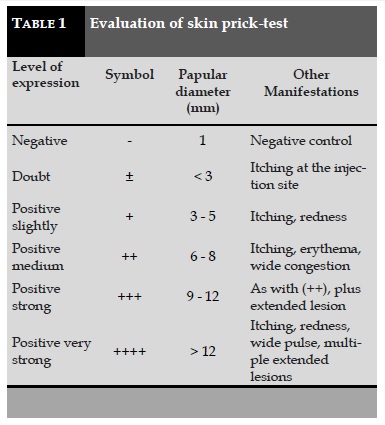
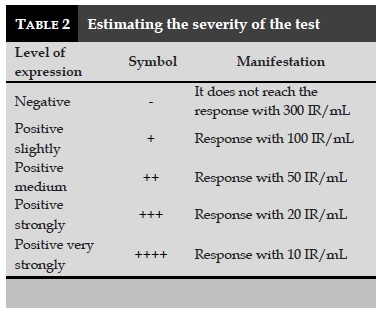
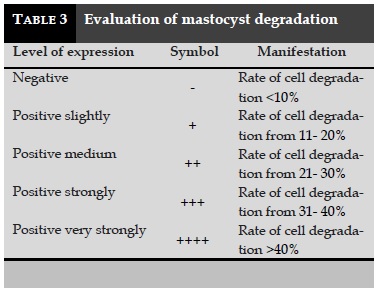
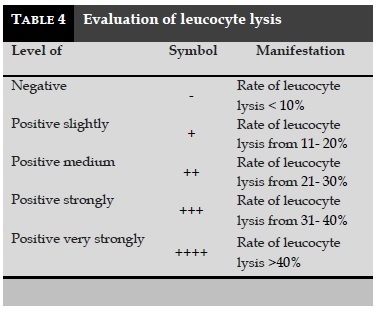
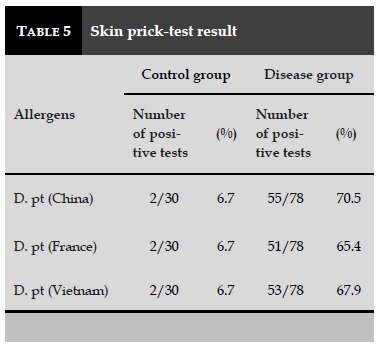
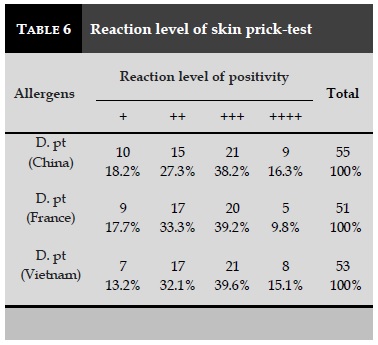

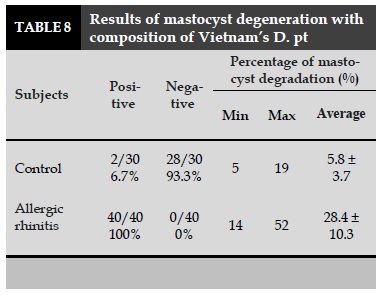
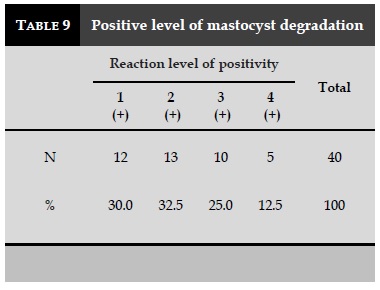
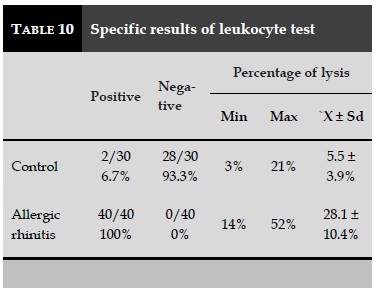
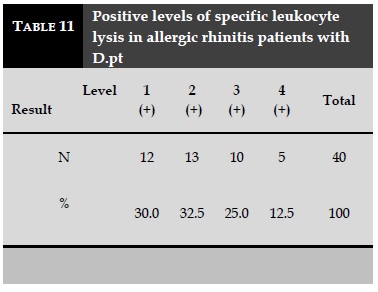
REFERENCES
1. Trinh Manh Hung. Some initial results on the diagno-sis and treatment of asthma bronchial asthma, disser-tation Doctor of Medicine, Hanoi Medical University 2000.
2. Vu Minh Thuc. Dermatophagoides pteronyssninus dust mite in allergy (theory and practice), Medical Publishing House 2004;3-45.
3. Bogg P.B. Allergic rhinitis (Translation). Medicine Publishing House 2008.
4. Phan Quang Doan. Allergy - Immunological Clinical, Education Publishing House 2009.
6. Vazquez Nava F., Sanchez Nucio H.R. A diagnostic instrument for allergic rhinitis. Rev. Allerg. Mex. 2000;47(4):130-3.
ARTICLE INFO
DOI: 10.12699/jfvpulm.9.28.2018.41
Conflict of Interest
Non
Date of manuscript receiving
Date of publication after correction
Article citation
Dinh Thi Dieu H, Pham Van T, Phung Chi T. Evaluate the vitality of Dermatophagoides pteronyssinus allergen through in vivo and in vitro tests . J Func Vent Pulm 2018;27(9):41-46.